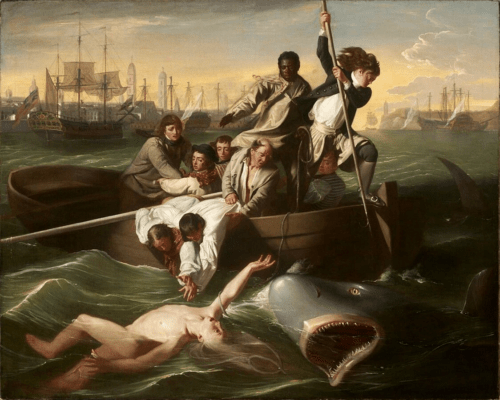A Regency Era inspiration for ‘Jaws’?

How much did Regency era England know about sharks? That’s a great question, and I’m glad you asked. In the most recent book, the major characters talk a lot about sharks and the fear they instilled in sailors. It makes a certain amount of sense that the sailors could know about sharks, but what about others? Would have been possible for a greater population to know and fear them without movies like ‘Jaws’ to spread the dread?
Turns out the answer is absolutely.
How? This painting for one.
In 1749, Brook Watson, a 14-year -old cabin boy on the Royal Consort lost his right leg below the knee in a shark attack in Havana harbor. Rescuers tried to save him three times before they were successful, but he not only survived, but thrived in the aftermath. The attack became the subject of the painting, Watson and the Shark.
Following his recovery from the injuries, Watson took a job on a schooner under Captain John Huston supply provisions to the British army in Nova Scotia. (1750) He continued his military career, becoming known as the ‘wooden-legged commissary’ until 1759 when he embarked on a mercantile career in London.

Robert Dighton (1752–1814) Public domain
He went on to serve as a member of the original committee of Loyd’s of London, serving ten years as it’s chairman. His business interests later included Brook Watson & Co that owned at least two whaling ships, and serving as a director of the Bank of England.
In addition, he was also active in politics serving as Alderman of the City of London, member of parliament for the same, Sherrif of London and Middlesex, Commissary-General to the Duke of York, and Mayor of London.
Somehow, in the midst of all that, he found the time to marry Helen Campbell in 1760. They had no children, though.
Watson commissioned John Singleton Copley to produce a painting commemorating the shark attack that took his leg. Finished in 1778, the painting Watson and the Shark was exhibited at the Royal Academy of Arts causing quite a sensation. Eventually three versions of the painting were done and have since hung in numerous galleries and museums.
In 1803 Watson was made baronet. Somehow, it is fitting that his coat of arms was designed to include his ordeal with the shark. Underneath the image of Neptune, god of the sea, brandishing his trident, a shield bears the likeness of Watson’s severed right leg, and the Latin motto Scuto Divino (‘Under God’s Protection’).
All that to say, there was good reason to believe that my characters would definitely have been aware of sharks and shark attacks!

OMG! That was amazing. What a courageous person. He was amazing. In the painting, his right leg is in shadow, or perhaps, what was left of it. Grief! He didn’t let his disability define him and went on to have more than a prosperous life. Goodness! What ambition. Thanks for sharing his story.
Fascinating. Shows that no matter how bad life gets, we can be triumphant. I love your random bits newsletter. Thank you.